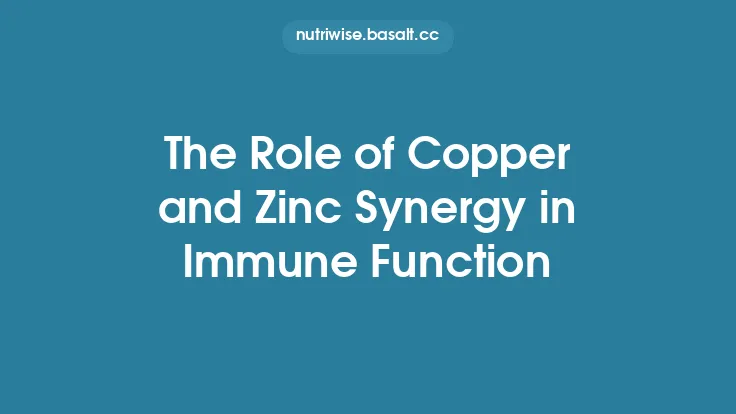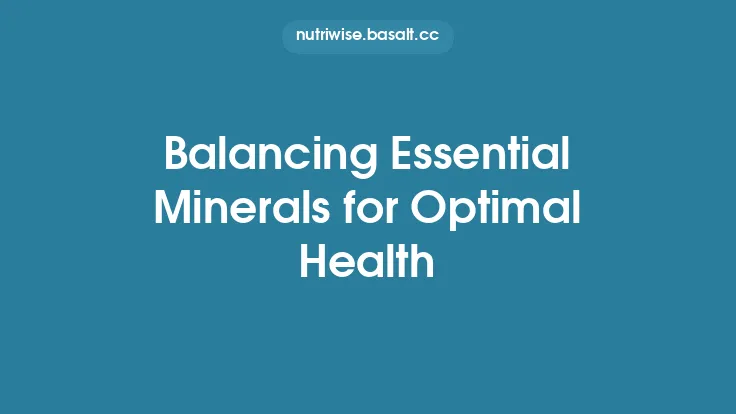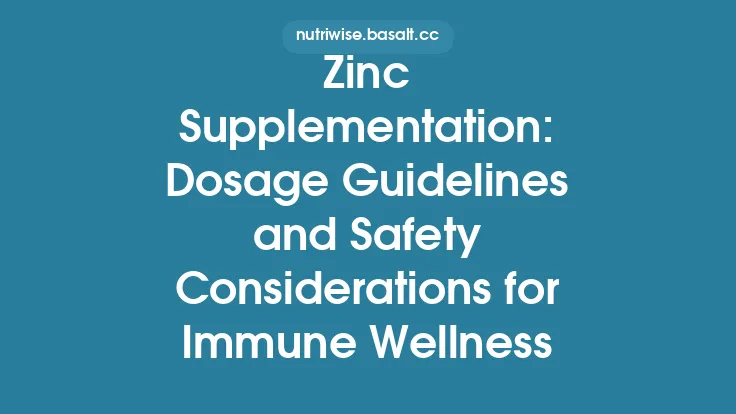Zinc and copper are two essential trace elements that the human body requires in only minute amounts, yet their physiological importance far exceeds their concentration. Both participate in a myriad of enzymatic reactions, structural functions, and signaling pathways. Because they share several transporters, binding proteins, and regulatory circuits, an excess of one can impair the status of the other—a phenomenon known as antagonistic interaction. Understanding the biochemical basis of this antagonism, the factors that modulate it, and the practical implications for diet and supplementation is crucial for clinicians, nutrition scientists, and anyone interested in maintaining optimal micronutrient balance.
The Biochemical Foundations of Zinc–Copper Antagonism
Shared Transport Systems
The intestinal epithelium expresses a limited set of divalent metal transporters that accommodate both Zn²⁺ and Cu²⁺. The most prominent are:
- Divalent Metal Transporter‑1 (DMT‑1) – originally characterized for iron, DMT‑1 also mediates low‑affinity uptake of Zn²⁺ and Cu²⁺, especially under conditions of high luminal concentrations.
- ZIP (Zrt‑Irt‑like Protein) Family – ZIP4 is the primary Zn²⁺ importer, but certain ZIP isoforms (e.g., ZIP8) can transport Cu²⁺ as well.
- CTR (Copper Transporter) Family – CTR1 is the high‑affinity Cu⁺ importer; however, in the presence of high Zn²⁺, CTR1 activity can be competitively inhibited.
When dietary zinc is abundant, it can saturate these transporters, reducing copper’s access to the enterocyte and vice versa. The net effect is a shift in the intracellular metal pool that influences downstream metabolic pathways.
Metallothionein (MT) Induction
Metallothioneins are low‑molecular‑weight, cysteine‑rich proteins that bind divalent metals with high affinity. Zinc is a potent inducer of MT synthesis in the intestinal mucosa and liver. Elevated MT levels preferentially sequester copper because Cu⁺ binds more tightly to the thiol groups than Zn²⁺. Consequently, high zinc intake can lead to functional copper deficiency by trapping copper within MT complexes, rendering it unavailable for incorporation into cupro‑enzymes such as cytochrome c oxidase and ceruloplasmin.
Ceruloplasmin and Copper Export
Ceruloplasmin is the major copper‑carrying protein in plasma and also possesses ferroxidase activity. Zinc influences ceruloplasmin synthesis indirectly through hepatic MT expression. When MT is up‑regulated, copper is retained intracellularly, limiting its incorporation into ceruloplasmin. This reduces plasma copper concentrations and can impair copper‑dependent oxidative processes.
Regulatory Hormones and Signaling Molecules
- Hypoxia‑Inducible Factor (HIF): Both zinc and copper modulate HIF stability. Excess zinc can inhibit prolyl hydroxylases, stabilizing HIF and altering expression of genes involved in iron metabolism, indirectly affecting copper homeostasis.
- Adenosine Triphosphate (ATP)‑Binding Cassette (ABC) Transporters: ABC transporters such as ATP7A and ATP7B export copper from cells. Zinc can affect the expression and activity of these transporters, further influencing copper distribution.
Dietary Sources and Typical Intake Ranges
| Food Category | Representative Sources | Approx. Zn (mg/100 g) | Approx. Cu (mg/100 g) |
|---|---|---|---|
| Meat & Poultry | Beef liver, chicken thigh | 4–6 | 0.5–1.0 |
| Seafood | Oysters, crab, mussels | 5–7 | 0.4–0.8 |
| Legumes & Nuts | Chickpeas, lentils, cashews | 2–3 | 0.3–0.5 |
| Whole Grains | Wheat germ, quinoa | 1–2 | 0.2–0.4 |
| Dairy & Eggs | Milk, cheese, egg yolk | 0.5–1 | 0.05–0.1 |
The Recommended Dietary Allowance (RDA) for adults is 8 mg/day for zinc (men) and 9 mg/day for women, and 0.9 mg/day for copper for both sexes. Typical Western diets often provide zinc at or slightly above the RDA, while copper intake can be marginal, especially in diets low in organ meats and shellfish.
Clinical Manifestations of Imbalanced Zinc–Copper Status
Copper Deficiency Induced by Excess Zinc
- Hematologic Effects: Anemia (often normocytic, normochromic) due to impaired iron mobilization, as ceruloplasmin‑mediated ferroxidase activity declines.
- Neurologic Signs: Peripheral neuropathy, gait disturbances, and myelopathy reminiscent of subacute combined degeneration.
- Immunologic Consequences: Reduced neutrophil oxidative burst and compromised cell‑mediated immunity.
- Dermatologic Findings: Premature graying of hair, depigmented skin patches, and brittle nails.
Zinc Deficiency Exacerbated by Copper Excess
- Growth Retardation: Particularly in children, due to impaired DNA synthesis and growth‑factor signaling.
- Dermatitis: Eczematous rash around orifices and acral areas.
- Taste Alterations: Dysgeusia and reduced appetite.
- Immune Dysfunction: Diminished thymic hormone activity and lower lymphocyte proliferation.
Strategies for Maintaining an Optimal Zinc–Copper Ratio
Dietary Diversification
- Combine High‑Zinc Foods with Copper‑Rich Counterparts: Pairing beef liver (high copper) with zinc‑rich grains can naturally balance intake.
- Include Whole‑Food Sources of Both Metals: Oysters provide a near‑ideal zinc‑to‑copper ratio (~10:1), which aligns with physiological needs.
Supplementation Guidelines
- Avoid High‑Dose Zinc Monotherapy: Doses exceeding 40 mg/day for prolonged periods increase the risk of copper depletion. If high zinc is clinically indicated (e.g., for Wilson’s disease or certain dermatologic conditions), concurrent low‑dose copper (e.g., 2 mg/day) is advisable.
- Timed Ingestion: Separate zinc and copper supplements by at least 2 hours to reduce competition at the intestinal transporter level.
- Formulation Considerations: Chelated forms (e.g., zinc picolinate, copper glycinate) may exhibit different absorption kinetics; however, the antagonistic effect persists at the transporter level, so timing remains important.
Monitoring Biomarkers
- Serum Copper and Ceruloplasmin: Primary indicators of copper status; low values suggest zinc‑induced sequestration.
- Plasma Zinc and Hair Zinc: Reflect recent intake and longer‑term stores, respectively.
- Metallothionein Expression (Research Setting): Quantitative PCR of intestinal biopsies can reveal up‑regulation due to excess zinc.
Population‑Specific Considerations
Pregnant and Lactating Women
Both zinc and copper requirements increase during pregnancy (zinc RDA ≈ 11 mg/day; copper ≈ 1 mg/day). Excess zinc supplementation without copper can jeopardize fetal neurodevelopment, as copper is essential for myelination.
Elderly Individuals
Age‑related decline in gastric acidity reduces mineral solubility, potentially limiting copper absorption. Concurrent high zinc intake (common in multivitamin formulations) may exacerbate this limitation, contributing to anemia and immune senescence.
Athletes and High‑Performance Individuals
Intense training elevates zinc losses through sweat and urine. Supplementation is common, but without careful copper monitoring, athletes may develop subclinical copper deficiency, affecting oxidative stress handling and recovery.
Emerging Research Directions
- Genetic Polymorphisms in Metal Transporters: Variants in ZIP4, CTR1, and ATP7A/B influence individual susceptibility to zinc‑copper imbalance. Genome‑wide association studies are beginning to map these relationships.
- Microbiome‑Mediated Modulation: While not the focus of this article, recent data suggest that gut microbial composition can affect metal speciation, indirectly influencing the antagonistic dynamics.
- Nanoparticle Delivery Systems: Encapsulation of zinc and copper in separate nanocarriers aims to temporally separate their release in the gastrointestinal tract, mitigating competition at the transporter level.
- Systems Biology Modeling: Computational models integrating transporter kinetics, MT binding affinities, and dietary inputs are being refined to predict optimal zinc‑copper ratios for various physiological states.
Practical Take‑Home Messages
- Balance is Key: Neither zinc nor copper should be viewed in isolation; their interdependence mandates a holistic approach to intake.
- Watch High‑Dose Zinc: Chronic supplementation > 40 mg/day without copper co‑supplementation is a common precipitant of copper deficiency.
- Use Food as the Foundation: Whole‑food sources naturally provide a more physiologically appropriate zinc‑to‑copper ratio than isolated supplements.
- Monitor When Supplementing: Periodic assessment of serum copper, ceruloplasmin, and zinc levels is advisable for individuals on long‑term zinc regimens.
- Tailor to Life Stage: Adjust zinc and copper recommendations based on age, sex, reproductive status, and activity level to avoid inadvertent antagonism.
By appreciating the shared pathways, regulatory mechanisms, and clinical consequences of zinc–copper antagonism, nutrition professionals can design diets and supplementation protocols that preserve the delicate equilibrium of these vital trace elements, supporting overall health and preventing micronutrient‑related disorders.





